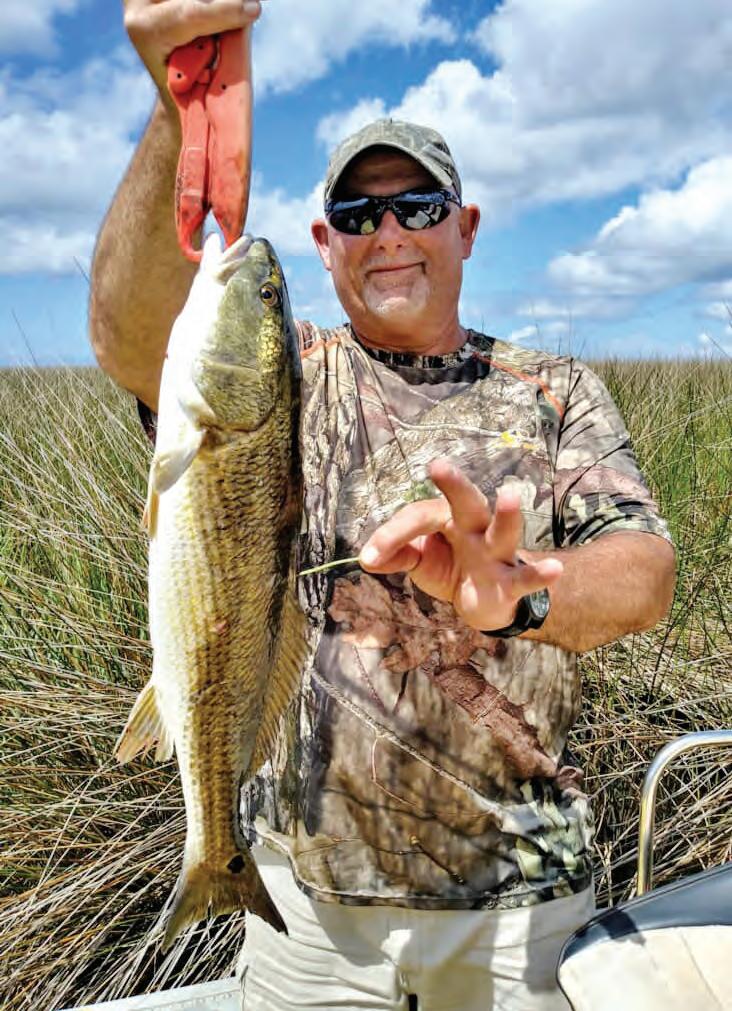
3 minute read
BLOB THE GREAT SEAWEED TARGETS FLORIDA!

By: Capt. Don Stansell
By now, I believe everyone has seen this sensational story in the mass media outlets over the past few months. The “Blob” stretches from West Africa to the Gulf of Mexico and is known as the Great Atlantic Sargassum Belt. Sargassum, a type of floating brown algae, had been predicted to be near or at record levels washing up on Florida beaches this summer.

When I hear the word sargassum, I don’t think of any “Blob” that is going to overtake Florida. I envision an Island Oasis for marine life in a vast desert-like environment of the open ocean. Most anglers dream of large schools of mahi circling down below drifting sargassum. This floating algae plays a critical role for many species of marine life including fish, crabs and shrimp. Juvenile hatchling sea turtles from nests located on both coasts of Florida find shelter and food amongst the sargassum seaweed. There are species like the sargassum fish that have evolved incredible camouflage abilities to match their sargassum habitat. Unsuspecting prey like small fish and shrimp can be easily ambushed.
Like anything else, too much of a good thing can be a bad thing. The University of South Florida’s Optical Oceanography Laboratory has been using satellite imagery to track and predict Sargassum seaweed blooms. They have called it the SaWS, or Sargassum Watch System. Due to the large amount of sargassum detected early this spring, it had been predicted to be a possible record year for sargassum seaweed blooms washing ashore. I believe the media had an easy time sensationalizing this narrative. Excess sargassum washing up on beaches does have a negative impact on people and marine life. There is a large economic burden on municipalities and countries throughout the Caribbean to rid their beaches of washed-up rotting sargassum that gives off hydrogen sulfide (rotting egg smell) and causes respiratory irritation in those who are sensitive to it. Water treatment facilities are also negatively impacted. The same nesting sea turtles that rely on floating sargassum for their young have trouble nesting on sargassum covered beaches. Sea turtle hatchlings have been documented failing to make it out of the sargassum covered nests and shores to open water. Decaying sargassum can deprive the shallows of oxygen and cause fish kills, as well.
There has not been an exact reason pinpointed for the increase in sargassum over the last number of years but, like the red tide and other harmful algal blooms, excess nutrients can fuel excessive growth. Excess nutrients from sources such as waste water, agriculture and fertilizers, to name a few are thought to be contributing factors.

The latest monthly bulletin by the Sargassum Watch System for May 31st shows a decrease by 15% in sargassum as compared to April. Such a decrease has never been recorded in the Great Atlantic Sargassum Belt back to 2011. June predictions are for a likely continued decrease in sargassum in the Gulf of Mexico, the Keys and along the East Coast of Florida. The great sargassum “Blob” may be both a little fact and a little fiction. I guess time will tell.

— Capt. Don Stansell is a local marine biologist who is an avid outdoorsman, fisherman and conservationist. He enjoys educating people on our coastal and marine environments. His passion for the water and outdoors grew from being raised on the bayous of Slidell, LA and in the Chesapeake Bay area of Annapolis, MD. He has been in sunny Florida for just over 20 years and really enjoys the outdoors year around.
Continued variety of species--especially mackerel this time of year.
There are times when you can go out and look for birds working the bait schools. Many times, it will be the mackerel pushing the bait to the surface. At times, you will see the mackerel coming out of the water free jumping after baits. Now, if you do not see surface hits that does not mean the mackerel are not there. They can be feeding down lower in the water column, so it is always worth it to cast a bait or spoon out and work the bait school. There are many artificial baits that mackerel love such as spoons that shine in the water from the sun along with jigs and bucktails. If you are using a bucktail, I find that if it has white as the dominate color or all white, you get more strikes. When working the artificial baits for the mackerel, do a countdown on your sink and try different depths and speeds until you start getting hits.
If you are getting bit off too often, a short piece of #2 or #3 wire about 8 inches long will fix the problem.

When rigging up for mackerel using live bait, I like about 3 to 4 feet of 30-pound test Seaguar fluorocarbon leader but, many times, regular leader will work fine. I like to use that with a long shanked #1 or 1/0 hook to get away from getting bit off too often. If you are getting bit off too often, a short piece of #2 or #3 wire about 8 inches long will fix the problem. I usually use wire when throwing lures, because I do not want to lose too many. I like to use a medium 8 to 17-pound rod with a fast taper for good casting and a flexible tip, so the hook doesn’t pull out on the blazing, drag screaming runs the mackerel are known for. Good luck and happy hunting.










